No products in the cart.
What Makes a George Nakashima Table So Unique?
- October 25, 2023
- -
There’s nothing else quite like a George Nakashima table. Nakashima’s fluid, natural-form tables vibrate with life as if bursting forth from the ground beneath.
Each of these tables is an exquisitely handcrafted masterpiece representing the American Studio Craft Movement and its father, George Nakashima.
Who Was George Nakashima?
Nakashima was born in Spokane, Washington in 1905 to Japanese-American parents. The early development of his artistic viewpoint came from his global travels and eagerness for enriching new experiences. After earning bachelor’s and master’s degrees in architecture, Nakashima purchased a round-the-world steamship tramp ticket and traveled to many locations notable for art and architecture, including France, Japan, and India.
He settled in India in the late 1930s, working as a construction supervisor and woodworker while immersing himself in Hindu Aurobindo spirituality. His beliefs later became the basis of the Nakashima Foundation for Peace, and Nakashima self-identified as a “Hindu Catholic Shaker Japanese American.”
Nakashima relocated to Seattle, Washington in 1940 and, like others of Japanese ancestry at the time, was imprisoned in a World War II internment camp. Undeterred, he collaborated with Japanese carpenter Gentaro Hikogawa to master traditional techniques of wood joinery, including butterfly inlays and dovetail corners. Together, Nakashima and Hikogawa built an intense focus on discipline and patience in woodworking.
In 1943, a benefactor sponsored Nakashima’s release from the internment camp, and he relocated to a studio in New Hope, Pennsylvania. Thus began perhaps the most prolific and well-known period of his career when he created his signature chairs and free-edge tables.
In a 1979 interview, Nakashima explained his artistic point of view. “When I’m making something out of a piece of wood, I have a long dialogue with it, sometimes for years. I have to find my own relationship with the spirit of a tree, and pretty soon, the wood evolves as a form.”
Nakashima traveled the world absorbing creative influences and making his unique handcrafted pieces until he died in Pennsylvania in 1990. His son, Kevin Nakashima, still lives in the historic family home George hand-built in 1945.
The Studio Craft Movement: Playful, Sculptural, One-of-a-Kind
What exactly is the Studio Craft Movement? The Metropolitan Museum of Art explains that the style developed in post-World War II America as inventive artists explored non-traditional techniques and materials. The movement is known for playful and provocative works, including sculptural wood chairs, chests, cabinets, and tables.
Moderne Gallery’s founder, Robert Aibel, told Effects Magazine that the definition of the Studio Craft Movement is fluid, just as the style itself is. “The definition can be rather loose,” Aibel says. “But it is basically the concept of a person making an object which is functional, and in most cases, sculptural, so that it’s both aesthetically pleasing and still functional.”
Aibel’s son and gallery co-director, Joshua Aibel, adds that the studio artist’s vision and process for creating each piece is just as important as the outcome. He says, “It’s the maker’s personal vision and the process of creation rather than the final product, which is usually a one-of-a-kind work of art.”
Unique Pieces From Nakashima’s Distinctive Vision
A George Nakashima table is among the ultimate expressions of his artistic genius. His signature live-edge wood tables combine free-form visual style with reverence for traditional woodworking techniques.
In Nakashima’s eyes, flaws in wood have inherent beauty. Logs that might otherwise have been discarded or destroyed are rescued and given new life. Using his slow, thoughtful design process, he carefully hand-shaped each plank into a timeless treasure.
Notable types of George Nakashima tables include:
Nakashima shared insight into his approach in his 1981 book The Soul of a Tree. He wrote, “Each flitch, each board, each plank can have only one ideal use. The woodworker, applying a thousand skills, must find that ideal use and then shape the wood to realize its true potential.”
His live-edge tables echo the Altar for Peace at The Cathedral of St. John the Divine in New York City. Nakashima built this enormous black walnut altar from the largest and most beautiful walnut log he’d ever seen. He hoped to bring world peace by installing similar altars throughout all continents on Earth. Other examples are located in Russia, India, and South Africa.
Some believe Nakashima’s spirit lives on within the wood fibers of his pieces, particularly his tables and altars. After Nakashima’s death, the Nakashima Foundation explained the Altar of Peace’s significance by writing, “In the ensuing years, prayers for peace in all tongues and traditions and by all peoples have been offered there. Mountains of flowers were lovingly placed upon it.”
George Nakashima Tables
Some of the very best pieces of George Nakashima are his tables. Here are a few of his finest tables recently held by Moderne Gallery.

Where To View George Nakashima Tables
Today, you can see some of the world’s finest examples of George Nakashima tables at Philadelphia’s Moderne Gallery. The gallery is a global leader in reviving the Studio Craft Movement by educating the world about the lasting impact of design legend George Nakashima.
Join Our Mailing List: Get the latest news, exclusive fair previews, and special access to new acquisitions.
We respect your privacy and promise to only send you the best content.
